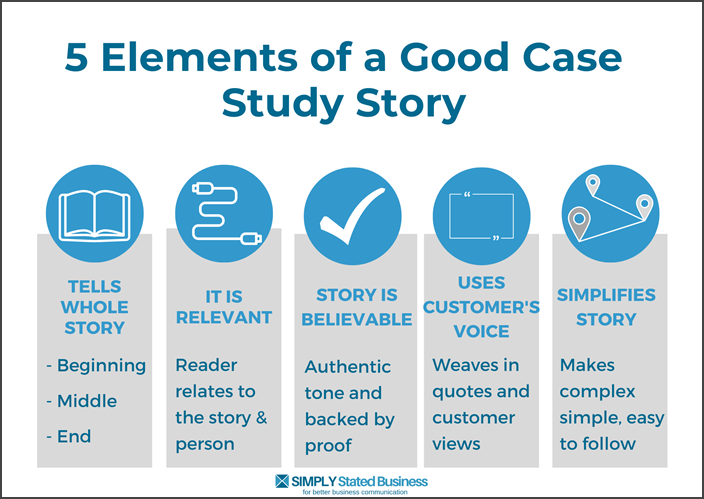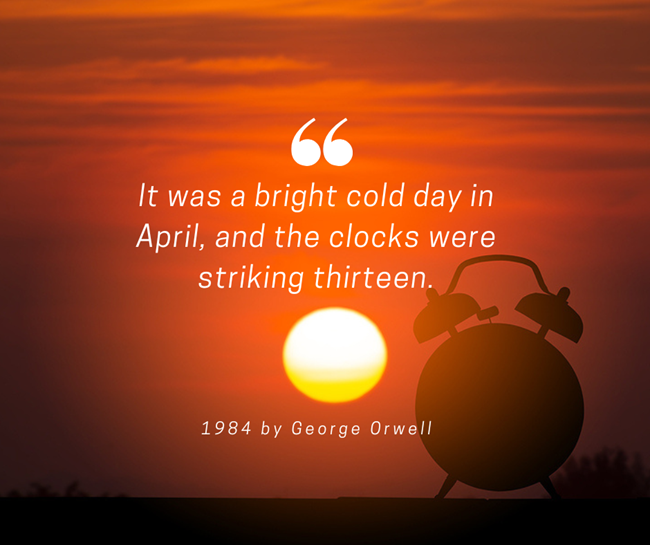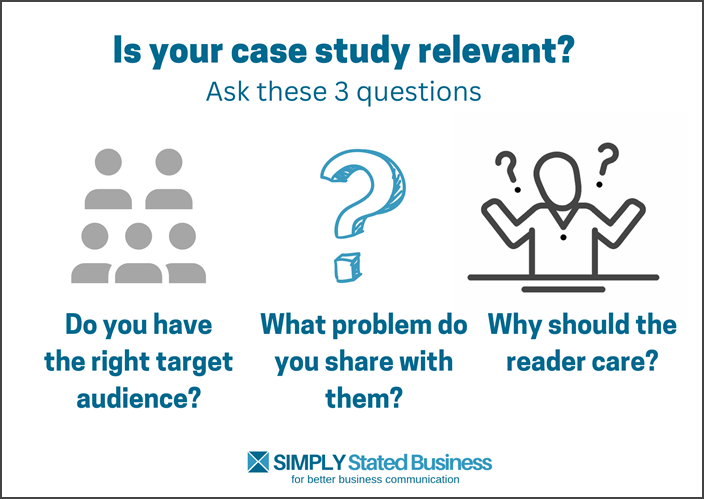If ever you wanted a case study on opinions, collect what’s been written about the proper case study length.
- Should only contain 500 – 1,500 words
- Two to five pages – top
- There are no hard rules.
I admit, I like the last argument.

But whichever length you subscribe to, certain elements consistently improve a case study by telling a good story.
Making a Case Study Work
Do you know why case studies work? It’s because people love a good story (heavy emphasis on good). The following are my Top 5 features of a good case study story.

1. Tells the Whole Story
Have you read a book or watched a movie that left you scratching your head? Maybe it was an ending that did not make sense. Or somewhere in the middle, you became lost.
Telling the whole story guides the reader to a satisfying conclusion.
The story has a beginning, middle, and end that work together in a cohesive package.
- Readers meet the lead character (the customer) who has a problem.
- They share the journey as the customer looks for a solution to their problem.
- In comes the hero (that’s you with your product or service).
- The customer tries it, loves it, loves you – success!
Each section smoothly transitions between the problem, the journey, and the solution. A case study that tells the whole story leaves readers wanting to share in its success.
2. It is Relevant
You know strong blog post headlines are click-changing, as are the soundbite-words of social media posts. You have a small window to snag attention.
It’s like reading a great first sentence from a book. One of my favorites was from George Orwell’s 1984.

Headlines in case studies tend to be a forgotten opportunity. Online or on paper, the headline is the invitation to read more. So, make it count. Make it relevant.
Use the following 3 questions to measure your case study relevancy.

The Right Audience
Like most business owners, I receive numerous pitches for products or services. The ones that drive me crazy are those that rise from lazy marketing.
I am a sole proprietor and a business writer. I have no staff or employees. So, how relevant do you think the following pitches are to me (all of which I have received)?
- Offers to handle my payroll
- Audit of phone system
- Human resources consulting
Shared Problem
I hate restrictive labeling, ripe with bias – like assumptions boomers want nothing to do with technology. Or Millennials have a sense of entitlement.
However, you may need to adjust a shared problem to make it relevant to a specific market segment. For example, who doesn’t share money concerns? But someone over 60 years of age is going to have a different focus than someone in their mid-30s.
Examples:
How Withdrawal Sequency Yields Retiree Nearly 50% More in Final Wealth Accumulation
The case study expands the story of the retiree concerned about making her retirement funds last. And how the author of the case study solves her problem.
Staged Savings Strategy Increase New Parents’ Monthly Savings Even with Higher Expenses
The new parents discover ways to increase savings even with the high cost of adding children to their family. Readers learn how the strategy worked.
Why Readers Care
This is the last question to ask before sending a case study out the door.
- Slip into the reader’s shoes.
- For each point, ask – why do I care?
- Then make sure you have an answer with evidence to prove it.
3. Story is Believable
In a book by a favorite author of mine, the lead character was buried alive in a box. She escaped, even though she had to fight off a wolf that was digging up and clawing at the box.
Believable? For me – not so much.
I still love my author, but she lost me from the beginning with this story. Your characters (client), their problems, and the solutions in your case studies must be believable.
Example of methods you can use to establish credibility include:
- Statistics of case study results or from other reliable resources
- Testimonials from customers with first-hand experience
- Feedback from colleagues before publishing the final version
If your case study is not credible, you might as well use it as a coaster.
4. Weaves in the Customer’s Voice
Picture your favorite characters from a novel.
- What made them your favorite?
- It probably was how real they were to you.
- You could almost hear their voice when they spoke.
A good case study uses the actual words of the customer. You take the passion and the happiness of this satisfied customer and share it.
You are victorious when readers like your case study customers and are happy for their success.
5. Simplifies the Story
Sometimes, the way your service or product works is complex. A case study with too many statistics or details overpowers the reader and the story is lost.
Think of a PowerPoint presentation with 100-plus slides and nothing but bullets and sub-bullets. I bet you can relate to that. Major snooze time.
Remember: Beginning, Middle, End.
- Beginning – what’s the problem?
- Middle – what’s been tried?
- End – what was the solution and results?
People remember good stories. If you want your product or service remembered, try sharing your success stories through case studies.
Ask those customers if they would share their story. Most are happy to do so.
Then go write a great story!
=========================
Note: The original post published June 4, 2010. This January 23, 2023 version is an update to that post.
Check out my free tips: 9 Ways to Use Case Studies
==================================
Helping you keep your business communication simple, clear, and uniquely yours.
==================================

0 Comments